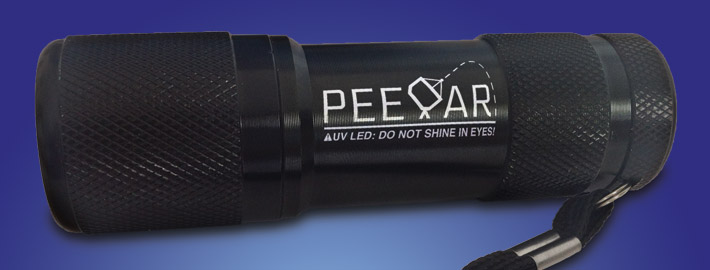Black Light Flashlight Tips – Never Miss A Pet Stain Again.
Pet urine is utterly repulsive on the best of days, and particularly embarrassing when having guests around – especially if it’s a dinner party!
You know your cat or dog has sprayed/urinated in the house somewhere, but can’t seem to find the evidence.
You’ve got your PeeDar – now there is NO NEED to slowly crawl around your house on your hands and knees feeling the ground for wet patches, looking for feint discolorations and sniffing the air for something disgusting. Just follow UES’s fail-safe procedure below for fast and easy pet stain detection!
- Plan Ahead – book time in the evening, or early morning, before daylight to begin your search for urine patches. Failing this, book time during the day if you are able properly black out each room you search.
- Wear Comfortable Clothes – walking and bending over to examine stains should not be difficult.
- Take Small & Lightweight Markers (e.g. Post-it notes, or failing that pieces of paper) that you can leave on each stain around the house that you find. This enables you to easily comeback when you’re ready.
- Add Batteries – ensure your brand new PeeDar has been filled with 3 fully charged regular AAA batteries.
- Start Where It’s Darkest – Aim to start your urine hunt at one end of the house, methodically and carefully moving through the whole of the house. If you’re searching during the day, start off in the darkest corner of the house to give you the best chance of seeing fluorescence e.g. basement, rooms with smaller windows etc.
- Don’t Waste Time, Move Efficiently -In each room hold the PeeDar approximately 2-3 feet from the carpet, and slowly walk (roughly half the average walking pace) along the length of the room moving the torch from left to right just in front of your feet. When commencing searching you’ll likely be right next to walls, so shine the torch up to your pet’s maximum height on the wall (and over anything adjacent to it such as curtains) as you move along the floor. When you’ve reached the end of the room, continue this searching process on the next approximately shoulder-width strip of the floor bordering the area you’ve just covered. Your movements will likely closely resemble that of someone mowing the lawn!
- Examine Fluorescence – If you notice any contrasting fluorescence, stop and take a closer look at it, and if you can bear it, sniff the air for any telltale pet urine smells (typically rancid and strongly ammonia-like). You may also want to move the torch closer to draw out more fluorescence. We’ve generally found that no closer than approximately half a foot works best for the maximum useful fluorescence. Cat and dog pee can often cover a wide area (2-3 foot or more) and so standing back a little, as well as moving the torch 1-2 foot away can help you to distinguish larger feint staining patterns. Additionally, don’t just search the walls and floor, animals such as cats can be very inventive with where they urinate, so be sure to examine anything they could realistically climb on e.g. cupboards, bookcases, under the sofa, behind the TV etc.
- Mark Suspect Areas – If you find an area that looks like a stain, put down markers so that they completely cover the suspect area, then resume your search. Typically you will find only “dried” pee stains, since liquid urine is unable to fluoresce much at all. Moisture detectors are better at detecting fresh urine stains, which by their very nature are usually visible and felt through touch anyway. Dried pee stains fluoresce brighter due to a more solid, crystalline molecular composition and are typically light green for cats, and light yellow for dogs – but these colors can vary depending upon the breed/species/diet/age/general health etc of the animal. If you’re just after urine stain eradication, ignore other stains of different colors e.g. detergents that often fluoresce as a much more vibrant light blue/violet white. Old stains (3+ months) can be faded in appearance under UV when compared to recent stains. Additionally, with thick fabrics such as carpets most stains can’t be 100% removed, and so although not smelling may always appear as a very feint fluorescing glow.
If you’ve followed our advice above,you can pat yourself on the back for a job well done! You’ve found all the stains to eradicate in a few easy steps. Have a good rest, before the next step – complete stain removal (in a supporting blog post coming shortly)!
Best regards
Urine Eradication Systems Team




We found plenty of stains with our PeeDar. But where are the stain removal tips! We have found an enyzme based product which works on fresh stains. The fluorescence is gone completely. But the week old stains glow as bright as ever even after extensive treatment. So how do we remove older stains please?!
Hi Paul,
We’re glad you’ve managed to find all sorts of stains, and many thanks for your good question here. We’re in the process of expanding our range of products to include powerful cleaning solutions and cleaning advice. We have a new pet behaviour eBook that comes with our PeeDar, included within is a bonus pet stain cleaning section that contains much of our current urine eradication knowledge and tips, so be sure to check it out. If you don’t have our eBook, send us your Amazon order ID using the contact form on our website and we’ll email you the eBook’s download link. We’re very proud of this unique and in-depth eBook written by a professional pet behaviourist and trainer, it contains all the info you need to safely and effectively, finally!, stop your furry one from committing the foul deeds in the first place.
From what we’ve seen so far, urine consists of an often extremely complex range of chemicals, which are not yet fully understood. Human urine has now been found to contain more than 3000 chemical compounds, a far greater number than was previously thought possible. Regards pets, cat urine has an equally complex mixture comprising of:
* Urea
* Urobilin/Urobilinogin
* Uric Acid
* Sodium
* Other electrolytes
* Creatinine
* Pheromones
* Bacteria – usually 5 different strains
Using a powerful enzymatic cleaner is definitely the way to go. After much research we’ve found that home-made household remedies which typically use a combination of vinegar, hydrogen peroxide and baking soda are not able to remove all the components of mammalian (cats, dogs, humans, we’re all mammals!) urine. Such remedies in-fact “set” the stain, making said stains considerably more difficult to remove with professional enzymatic cleaners. Your older stains may be harder to remove if you tried such remedies.
Vinegar and baking soda do effectively temporarily neutralise urine odour, and hydrogen peroxide is supposedly 30% more oxidising than the traditional cleaning chemical chlorine. The main problem is that these chemicals can’t remove ALL constituents of urine, specific enzymes must be present to remove to break down the chemical bonds of uric acid and its salts. Urea, urobilin/urobilinogin, creatine and phermones are water soluble, and so can be removed with traditional cleaning methods. Uric acid and its salts are not water soluble, and bond tightly to whatever surface they come into contact with. Over time, even if the other water soluble components are removed, in the presence of moisture uric acid salts start to form uric acid crystals that release the familiar urine smell (although at much lower quantities often only pets can detect) attracting pets to continue peeing in the same place.
Quality enzymatic cleaners break uric acid down into carbon dioxide and ammonia, both of these gasses quickly evaporate. Allowing “drying” time is an essential part of enzymatic cleaning, enabling the gasses to fully dissipate. We’re not sure what enzymatic cleaner you’re using, but highly regarded, effective and reliable brands are Nok Out, Urine Off, and Anti-Icky Poo. They may cost a bit more, but will be much more cost effective in the long run.
Any cleaner must also be used properly. Often cleaning solutions come in small spray bottles. Just a few sprays may sometimes work on small fresh stains, but generally, you should always take the lid off and douse/drench the whole stained area, going a few inches wider than the stain (and a few more inches on thicker/more absorptive carpets/surfaces). Instructions are generally very simple e.g. blotting urine beforehand, then soaking the area with cleaning fluid, letting the enzymatic solution sit for 10-15 minutes, blotting up the cleaner and then leaving the spot to air dry. Covering the stained area (e.g. with a towel, upturned laundry basket) is also recommended, it stops people stepping in the area and pets from urinating on it.
Generally, older stains need to be treated 2-3 times for complete removal – remember to allow the stain to fully dry between applications of remover fluid!
For very porous and absorptive surfaces, e.g. cushions, the important thing is to ensure that your enzymatic cleaning solution is absorbed into all the same places your pet’s pee was. Slow pouring onto and soaking of such materials is best, once fully drenched you can leave the enzymatic cleaner to act for 10-15 minutes. Remember to blot out as much of the urine first. Do be prepared for absorptive materials to literally take days to dry! Leaving out treated pillows and the like to dry in the sun can help.
Lastly, remember that certain cleaning chemicals themselves glow more profusely under UV than urine, usually having a strong light blue colour rather than the typical light yellow/green hue of cat or dog urine.
I hope this information is of help to you. Essentially, very thorough and repeated cleaning attempts using the best enzymatic cleaner are needed to stand the best chance of completely breaking down the most stubborn components of your urine stains. We’ll be posting more cleaning info over the coming months, so be sure to check out our blog now and then.
If for some reasons your stains are proving impossible to remove we suggest talking to a professional, time-honoured stain removal service. They’ve come across a wide range of stain-related circumstances and are usually therefore in the best position to offer an explanation for why certain stains just aren’t budging!
Best regards
Mike & Steve
[Co-Founders – Urine Eradication Systems]